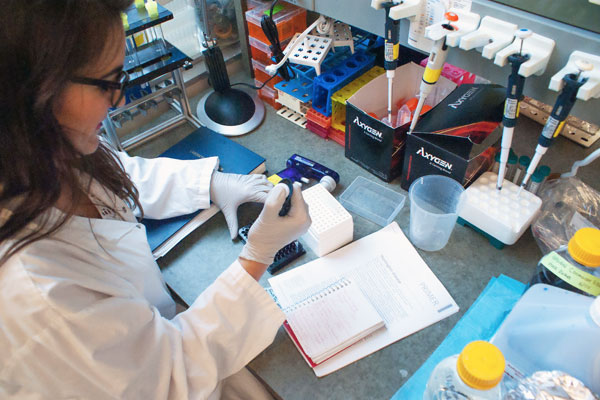Huntington’s Disease Researcher Shares Ongoing Lab Experiments, Data to Drive Collaboration

University of Toronto researcher Rachel Harding. (Credit: Melissa Hooper)
A Huntington’s researcher at the University of Toronto — Rachel Harding — will be the first biomedical scientist known to share documentation of her experiments in real-time. She is also inviting the public to scrutinize her work through her blog, another move that she hopes will accelerate research into Huntington’s disease.
“This should drive the process faster than working alone,” Dr. Harding said in a press release. “By sharing my notes, I hope that other scientists will critique my work, collaborate and share data in the early stages of research.” Dr. Harding is a post-doctoral fellow working within the Structural Genomics Consortium (SGC) at the University of Toronto (UT). Her work is funded by the CHDI Foundation, a non-profit drug development organization working to accelerate treatment development for Huntington’s disease. Both the SGC and the CHDI Foundation share the goal of advancing research through openness and collaboration.
Dr. Harding hopes to counterbalance current approaches to data-sharing within the scientific community. There is a long tradition of individual researchers or groups working in isolation from peers in the same field. Scientists also tend to publish only their positive findings, and research is usually published years after experiments are performed. This leads to a situation were scientists pursuing similar goals repeat the same mistakes or duplicate work.
She is now sharing raw data and detailed commentaries of her experiments on the digital research repository Zenodo, an initiative by the European Organization for Nuclear Research (CERN), and on OpenAIRE. In addition, she posts experiment updates on her blog Lab Scribbles, allowing anyone with interest to access summaries of her research written in everyday language.
Despite decades of research into Huntington’s disease, scientists still don’t know how the exact structure of the huntingtin protein responsible for the disease. “This is a very large protein and difficult to study. It is significantly larger than most other proteins in the cell,” said Dr. Harding.
The protein also has a complicated structure and is not similar to most known proteins. It is, therefore, difficult to draw conclusions about huntingtin by comparing it to other proteins. She hopes that the insight she provides will allow her to establish new collaborations and open discussions with fellow researchers. She also hopes to engage other people, such as patient communities, in her work.
“This is what research is really like,” Dr. Harding said. “It’s not so much about big breakthroughs and polished results, but about incrementally getting closer to an answer. I think by being more open about our research, we can all learn how to do the experiments better.”
Her efforts well match CHDI’s idea of being a “collaborative enabler” – bringing people and resources together to advance research into Huntington’s — and the SGC’s reasons for opening access to a host of its data and reagents.
“By providing access to raw data as well as the enabling research tools, we will help the community perform more robust experiments, which will accelerate the drug discovery process and potentially the development of new medicines,” Aled Edwards, a professor of medical biophysics at UT and director and CEO of the SGC, said in the release.






